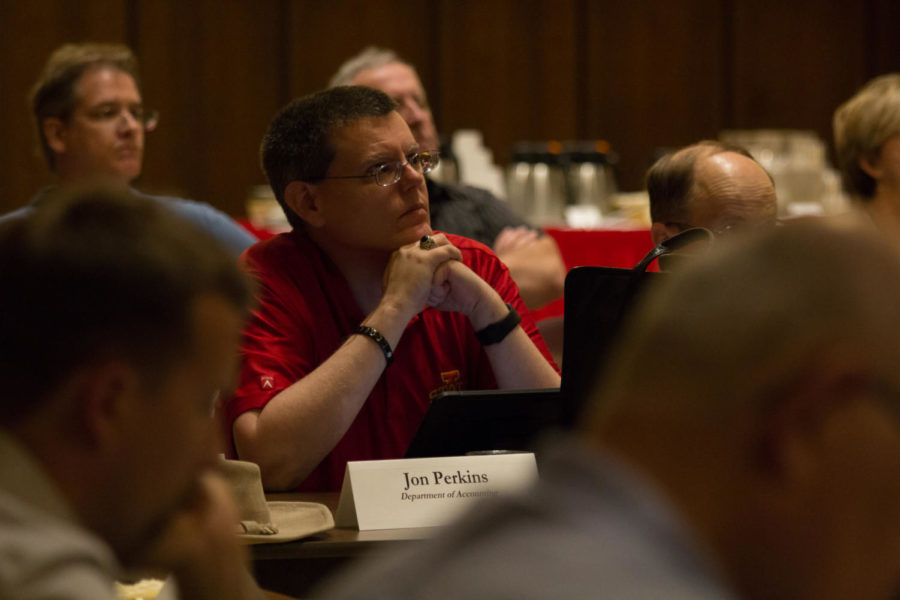Canvas is Coming, Faculty Senate Learns how to prepare for it
Mikinna Kerns/Iowa State Daily
The Department of Accounting representative Jon Perkins listens to a presentation about Canvas, ISU’s new learning Management system during the Faculty Senate meeting Sep. 12 in the Great Hall.
September 12, 2017
Canvas is now being used by 301 instructors, reaching 17,070 students for the fall 2017 semester.
Members of the Faculty Senate were presented with an update on the program’s success and how faculty can improve their familiarity with it during the regularly scheduled Sept. 12 meeting.
“Canvas was selected after an exhaustive process,” said Sara Marcketti, interim director of the Center for Excellence in Learning and Teaching.
“Part of the reason it was selected was for its intuitive design and easy navigation.”
Canvas can be easily learned by users of various technological skill due to the vast amount of resources available for training and learning purposes, Marcketti said.
“One of the most incredible elements of Canvas is the amount of resources that are available for learning, working and troubleshooting using the learning management system,” Marcketti said.
One option is a more self-directed learning approach, which includes online training, curated and non-curated videos on how to use Canvas and a Canvas community in which questions can be asked and answered among users.
Orientation courses for teachers and students are available through MyCanvas Teacher and MyCanvas Student, Marcketti said.
On a more face-to-face level, the Center for Excellence in Learning and Teaching will be hosting open labs for Canvas around campus, as well as training sessions with a professional on Sept. 18 through Oct. 1.
In the spring, all courses will be taught in Canvas. According to Mike Lohrbach, director of the Office of the Cheif Information Officer, there will be 24/7 services available for Canvas support.
In addition to the Canvas update, the senate was introduced to several diversity and inclusion projects by Vice President of Diversity and Inclusion Reginald Stewart.
The Mindfulness Room, which is now open for students, is located at Parks Library, room 297. The room, according to Stewart, is meant to allow for students, faculty and staff to reflect without a religious implication.
This idea was brought to the Office of Diversity and Inclusion by those on campus who felt there was a need for such a room.
Another diversity and inclusion project, which will be taking place from Oct. 3- 31, is the Campus Climate Survey.
The survey will be given to students, faculty and staff to determine the campus climate in order to show any progress, as well as to give a new collection of data for review in future diversity and inclusion efforts, Stewart said.
The last survey was done in 2004, and, according to Stewart, it is necessary to ensure that there is representation from all types of students from all levels of success in order to have a successful survey of the campus.
Another survey, entitled the Collaborative on Academic Careers in Higher Education Survey, was taken in 2016 to assess faculty satisfaction in institutional experiences.
Harvard Graduate School of Education puts on this survey in which 112 instituations participate to provide both national and peer benchmarks.
At Iowa State, 49% of faculty responded to the survey, allowing for comparison with the following peer institutions: North Carolina University; Purdue University; Oklahoma State University; University of California Davis; and University of Minnesota Twin Cities.
If a university is ranked first or second among its peers, or in the top 30% nationally in a certain area, that area is considered an area of strength.
According to the survey, Iowa State’s areas of strength include appreciation and recognition, collaboration, department quality, leadership at the divisional level, health and retirement benefits, interdisciplinary work, leadership at the senior level, mentoring, nature of work, and personal and family policies.
If a university is ranked fifth or sixth among peers or in the bottom 30% nationally, this area is considered a concern.
According to this survey, there were no areas of concern to be noted at Iowa State.
During the next senate meeting, the second reading and vote on discontinuing a post-professional degree in landscape architecture, due to lack of interest and enrollment, according to the legislation, and a change in the wording of the U.S. Diversity and International Perspective Requirements.







